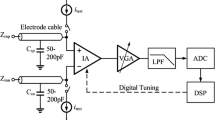Abstract
We present the design of an instrumentation biopotential amplifier that, (a) combines the ac coupling and high input impedance of an ac-coupled buffer with the CMRR of a simple differential amplifier or a monolithic instrumentation amplifier, (b) improves the CMRR by using a potentiometer without requiring either precision resistors or high-CMRR op amps, (c) illustrates how to calculate the CMRR for differential-input stages for either differential output or single-ended output. With our approach, for the 741 op amp, the CMRR of the differential stage exceeds 126 dB at 10 Hz and 106 dB at 100 Hz, which is higher than the 90 dB of the op amp alone. This is because a potentiometer permits mismatch of the resistor ratio, which compensates for the low CMRR of the op amp. Use of the LF355 op amp, which has a wider bandwidth, yields a CMRR of 126 dB at both 10 and 100 Hz. If the second stage is an instrumentation amplifier then no adjustment is necessary. Mismatch of passive components in the bootstrapped input buffer stage decreases the CMRR from 126 dB to 112 dB at 60 Hz and decreases it further at lower frequencies, but that is not a problem for the usual power-line interference.
Similar content being viewed by others
Abbreviations
- A c :
-
op-amp open loop common mode gain
- A d :
-
op-amp open loop differential mode gain
- A 0 :
-
op-amp open loop dc gain
- CMRR:
-
common mode rejection ratio
- CMRR B :
-
common mode rejection ratio for the input stage
- CMRR D :
-
common mode rejection ratio for the differential stage
- CMRR IA :
-
common mode rejection ratio for IC instrumentation amp
- CMRR OA :
-
common mode rejection ratio for the op amp
- CMRR OA (0):
-
common mode rejection ratio for the op amp at dc
- CMRR T :
-
total common mode rejection ratio for the circuit
- G c :
-
common mode gain of second stage
- G d :
-
differential mode gain of second stage
- G DC :
-
gain from the common mode input to differential output
- G DD :
-
gain from the differential mode input to differential output
- H(s),H 1(s),H 2(s):
-
transfer function of input buffers
- IMRR:
-
isolated mode rejection ratio
- k 1,k 2 :
-
resistors' ratios
- υ a υ b :
-
buffers' output voltages
- υ’ a υ’ b :
-
input voltages to the op amp
- υ c :
-
common mode input signal
- υ d :
-
differential mode input signal
- υ o :
-
output voltage
- υ C :
-
common mode output signal for the input stage
- υ D :
-
differential mode output signal for the input stage
- υ1υ2 :
-
input voltages
- Z C :
-
common mode input impedance
- Z CE :
-
effective coupling impedance
- αα a :
-
resistors' ratio mismatch
- β:
-
resistors' tolerance
- τ1τ2τ m τ a τ n :
-
time constants
- ω a :
-
op-amp unity gain frequency
- ω n :
-
low-pass corner frequency for input buffers
References
Hamstra, G.H.; Peper, A.; Grimbergen, C.A. Low-power, low-noise instrumentation amplifier for physiological signals. Med. & Biol. Eng. & Comput. 22:272–274; 1984.
Huhta, J.C.; Webster, J.G. 60-Hz Interference in electrocardiography. IEEE Trans. Biomed. Eng. BME- 20:91–101; 1973.
Maas, A.J.J.; Rodenberg, M. Digital automatic circuit for over-range correction. Med. & Biol. Eng. & Comput. 20:245–247; 1982.
McClellan, A.D. Extracellular amplifier with bootstrapped input stage results in high common-mode rejection. Med. & Biol. Eng. & Comput. 19:657–658; 1981.
Neuman, M.R. Biopotential amplifiers. In: Webster, J.G., ed. Medical instrumentation: application and design. Boston: Houghton Mifflin Co.; 1978: pp. 307–309.
Pallás-Areny, R. Interference-rejection characteristics of biopotential amplifiers: a comparative analysis. IEEE Trans. Biomed. Eng. BME-35:953–959; 1988.
Pallás-Areny, R.; Colominas, J.; Rosell, J. An improved buffer for bioelectric signals. IEEE Trans. Biomed. Eng. BME-36:490–493; 1989.
Schoenfeld, R.L. Common-mode rejection ratio-two definitions. IEEE Trans. Biomed. Eng. BME-17:73–74; 1970. Comments in BME-17:358; 1970. Further comments in BME-18:251; 1971.
van Heuningen, R.; Goovaerts, H.G.; de Vries, F.R. A low noise isolated amplifier system for electrophysiological measurements: basic considerations and design. Med. & Comput. 22:77–85; 1984.
Author information
Authors and Affiliations
Additional information
Until August 1, 1990, address correspondence to R. Pallás-Areny, c/o Prof. John G. Webster, Department of Électrical and Computer Engineering, University of Wisconsin-Madison, 1415 Johnson Drive, Madison, WI 53706-1691.
Rights and permissions
About this article
Cite this article
Pallás-Areny, R., Webster, J.G. Composite instrumentation amplifier for biopotentials. Ann Biomed Eng 18, 251–262 (1990). https://doi.org/10.1007/BF02368441
Received:
Revised:
Issue Date:
DOI: https://doi.org/10.1007/BF02368441




